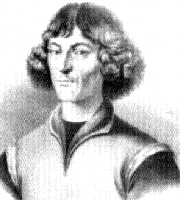| Profile | Major Works | Resources |
Nicolaus Copernicus, 1473-1543.

Famous 16th Century Polish astronomer, mathematician and clergyman.
In 1543, Copernicus published his most famous treatise, De Revolutionibus Orbium, presenting, for the first time, a completely "heliocentric" theory of astronomy (i.e. that the planets revolve around the sun). This theory was not articulated with revolutionary ardor. Rather, it was a practical proposition, by which Copernicus hoped to reconcile the conflicting observations which had forced astronomers to add epicycles upon epicycles to make the old Ptolemaic theory "work". That the hypothesis also undermined Aristotelean cosmology and Biblical scripture did not seem to occur to him. Copernicus's treatise was not proscribed by the Church until the 17th Century, after firebrands like Bruno and Galileo had taken up the heliocentric system with revolutionary zeal.
Copernicus' methodology of "reducing" conflicting empirical observations to "single" causes also applies to his famous 1526 work on monetary theory (it was not published until the 19th Century). Contemporary theorists had argued that general price inflation could be generally attributed to a reduction in the "intrinsic metal content" of coins. This certainly seemed to confirm the empirical observation that currency debasements were usually followed by inflation. However, this failed to account for other episodes of inflation which were not clearly attributable to currency debasement. Observers had speculated that these other episodes were due perhaps to "clipping", "forgery" and other shenanigans that reduced the "intrinsic content" of coins.
As he had done in astronomy, Copernicus must have sensed the "epicycles-upon-epicycles" character of these "further" explanations and proposed a single unifying theory: the Quantity Theory of Money. In his 1526 tract, Copernicus identified the single common cause of all inflation as the general increase in the quantity of coins minted from any given metal basis. This theory was later discovered (independently) by Bodin, Davanzati, Navarrus and the Salamanca scholars.
|
Major Works of Copernicus |
|
HET
|
|
Resources on Copernicus
|
All rights reserved, Gonšalo L. Fonseca
